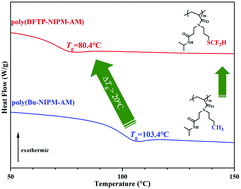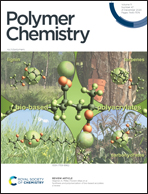Construction of well-defined difluoromethylthio-containing amphiphilic homopolymers by RAFT polymerization†
Abstract
A new acrylamide monomer consisting of both difluoromethylthio and isopropylamide moieties, N-3-(difluoromethylthio)propyl-N-(3-(isopropylamino)-3-oxopropyl)acrylamide (DFTP-NIPAM-AM), was firstly synthesized from 3-difluorothiomethyl-1-propylamine via aza-Michael addition reaction followed by amidation with acryloyl chloride. A well-defined fluoropolymer with a relatively narrow molecular weight distribution, poly(DFTP-NIPAM-AM), was obtained via reversible addition–fragmentation chain transfer (RAFT) polymerization using 3-(benzylthiocarbonothioylthio)propanoic acid as chain transfer agent. The thermal property of the poly(DFTP-NIPAM-AM) homopolymer was examined by differential scanning calorimetry (DSC), which indicated that difluoromethylthio moiety has an obvious impact on the glass transition temperature (Tg). The critical micelle concentration (cmc) of poly(DFTP-NIPAM-AM) homopolymer in aqueous solution was determined by fluorescent probe technique. It was found that poly(DFTP-NIPAM-AM) homopolymer could self-assemble into spherical micelles in aqueous solution, which was visualized by transmission electron microscopy (TEM).



 Please wait while we load your content...
Please wait while we load your content...